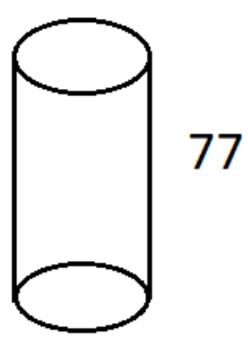
A metal pipe is 77 cm long. The inner diameter of a cross-section is 4 cm, the outer diameter being 4.4 cm. find its
(i) inner curved surface area.
(ii) outer curved surface area.
(iii) total surface area.


Answer
497.7k+ views
Hint: We will use the formula of the surface area of cylindrical things. A metal pipe is in the shape of a cylinder. The length is given. The surface area will be different for outer surface and inner surface. The formula for surface area is dependent on the radius of the figure. For the inner and outer surface area the radii are different. So, we will get different values. For the total surface area, we need to add up both inner and outer surface area.
Complete step-by-step solution:
The given figure of the metal pipe is of a cylindrical shape. It has both inner and outer diameter which means the figure has a measurable thickness. So, the inner and outer surface area will be different.
Now, the length of the metal pipe is 77 cm. So,
Let, the inner and outer radius of the pipe be
Given that, the inner diameter of a cross-section is 4 cm and the outer diameter being 4.4 cm.
So, the radius is half of the diameter.
We know that formula of the surface area of a cylinder is
So, for the inner surface area
We put the values in the formula to get the surface area.
The inner surface area
The outer surface area
The total surface area is the sum of the inner and outer surface areas.
So, total surface area is
Note: We need to always remember the difference between the inner and outer surface area as it’s just because of the thickness of the figure. If the thickness is missing then we would only have one kind of thickness i.e. both side surface area will be of the same value. We tried to process the formula using a radius. But to minimize our problem we can also use the diameter as instead of using
Complete step-by-step solution:
The given figure of the metal pipe is of a cylindrical shape. It has both inner and outer diameter which means the figure has a measurable thickness. So, the inner and outer surface area will be different.
Now, the length of the metal pipe is 77 cm. So,
Let, the inner and outer radius of the pipe be
Given that, the inner diameter of a cross-section is 4 cm and the outer diameter being 4.4 cm.
So, the radius is half of the diameter.
We know that formula of the surface area of a cylinder is
So, for the inner surface area
We put the values in the formula to get the surface area.
The inner surface area
The outer surface area
The total surface area is the sum of the inner and outer surface areas.
So, total surface area is
Note: We need to always remember the difference between the inner and outer surface area as it’s just because of the thickness of the figure. If the thickness is missing then we would only have one kind of thickness i.e. both side surface area will be of the same value. We tried to process the formula using a radius. But to minimize our problem we can also use the diameter as instead of using
Latest Vedantu courses for you
Grade 11 Science PCM | CBSE | SCHOOL | English
CBSE (2025-26)
School Full course for CBSE students
₹41,848 per year
Recently Updated Pages
Master Class 10 General Knowledge: Engaging Questions & Answers for Success

Master Class 10 Computer Science: Engaging Questions & Answers for Success

Master Class 10 Science: Engaging Questions & Answers for Success

Master Class 10 Social Science: Engaging Questions & Answers for Success

Master Class 10 Maths: Engaging Questions & Answers for Success

Master Class 10 English: Engaging Questions & Answers for Success

Trending doubts
Give 10 examples of unisexual and bisexual flowers

Draw a labelled sketch of the human eye class 12 physics CBSE

Differentiate between homogeneous and heterogeneous class 12 chemistry CBSE

Differentiate between insitu conservation and exsitu class 12 biology CBSE

What are the major means of transport Explain each class 12 social science CBSE

What is the difference between resemblance and sem class 12 social science CBSE




